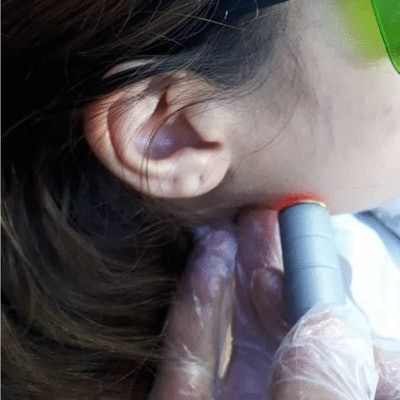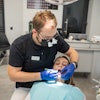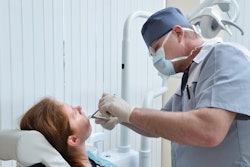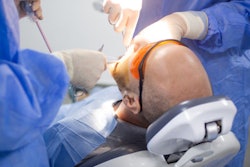
Administering an extraoral low-level diode laser for one session of irradiation following wisdom tooth surgery may decrease patient pain, according to the results of a clinical trial recently published in BMC Oral Health.
Though laser treatment did not seem to make a noteworthy reduction in edema or trismus, using a 940 nm low-level diode laser decreased the number of analgesics patients took after surgery, the authors wrote.
"Single-session irradiation of 940 nm diode laser can effectively decrease pain following third molar extraction surgery," wrote the authors, led by Dr. Parisa Sanaei-rad of Arak University of Medical Sciences in Iran (BMC Oral Health, September 20, 2022, Vol. 22, 417.).
A new pain management strategy
Due to intraoperative trauma, extractions of impacted third molars in the lower jaw often are associated with postoperative complications, including pain and edema. In many cases, the pain starts about five hours after surgery, gradually decreasing for about a week. To minimize complications, multiple strategies, including prescribing analgesics, cryotherapy, and varying surgical closure techniques have been suggested.
Considering the side effects of analgesics and the relative ineffectiveness of some of the other suggested strategies, laser therapy may be a possible alternative. Though low-level lasers are used to accelerate tissue regeneration, treat some temporomandibular disorders, and enhance wound healing, their efficacy for pain relief following surgical wisdom tooth extraction remains controversial. Only a limited number of studies have reported the optimal clinical effectiveness of low-level laser therapy for decreasing postoperative pain, edema, and trismus.
To explore the effect of low-level diode laser therapy on pain, edema, and trismus following surgical extraction of wisdom teeth, the researchers conducted a split-mouth, randomized, placebo-controlled clinical trial in 25 healthy adults with asymptomatic, bilaterally impacted mandibular third molars.
One side of the patient's jaw was randomly assigned to receive the laser, and the other side was assigned to the control group. Immediately after third-molar surgeries, the laser quadrant received 940 nm diode laser irradiation (0.5 W, 10 J/cm2, continuous-wave mode for 20 seconds) at three points in the masseter muscle in contact mode, the authors wrote.
 The fiber tip of the laser contacted the skin, and the laser was irradiated to a triangular area hypothetically formed between the point of insertion of the masseter muscle at the angle of the mandible, the tragus lobe of the ear, and the mesial side of the mandibular second molar. Images courtesy of Sanaei-rad et al. Licensed by CC BY 4.0.
The fiber tip of the laser contacted the skin, and the laser was irradiated to a triangular area hypothetically formed between the point of insertion of the masseter muscle at the angle of the mandible, the tragus lobe of the ear, and the mesial side of the mandibular second molar. Images courtesy of Sanaei-rad et al. Licensed by CC BY 4.0.To determine edema, the distance between the patient's chin point and the inferior border of the external auditory canal was measured. To determine trismus, the distance between the incisal edges of a patient's upper and lower right incisors in maximum mouth opening was measured using a calibrated digital caliper before and after surgery and two days and seven days after surgery. A visual analog scale was used to measure pain, and patients were asked to keep a log of their pain scores for seven days and the number of analgesics they took during this period, they wrote.
After surgery, patients were prescribed 400 mg of ibuprofen every 12 hours for three days, as well as antibiotics and a chlorhexidine mouthwash.
In the control group, the mean pain score was significantly higher in the first seven days after surgery compared to those who received a laser session. Repeated measures of statistical tests showed pain scores descending in each group (p < 0.05). In this respect, the difference was significant between both groups, and the mean change in pain score was lower in the laser group, the authors wrote.
For analgesics, the mean number taken was significantly lower in those that received the laser therapy session (5.4 ± 2.98 vs. 11.08 ± 5.18, p = 0.00).
 Mean pain scores of patients who did and did not receive laser therapy at different time points.
Mean pain scores of patients who did and did not receive laser therapy at different time points.Nevertheless, the trial's small sample size was a limitation of the study. Studies that include larger sample sizes and different laser types and parameters should be conducted in the future, the authors wrote.
"Although pain and edema were lower in the laser group after surgery, this difference was only significant for pain," Sanaei-rad et al wrote.




















